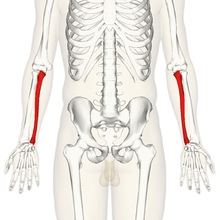singcsont
Hungarian

singcsont (shown in red)
Etymology
sing (“cubit”) + csont (“bone”). First attested in 1828. Created during the Hungarian language reform which took place in the 18th–19th centuries.[1]
Pronunciation
- IPA(key): [ˈʃiŋkt͡ʃont]
- Hyphenation: sing‧csont
Noun
singcsont (plural singcsontok)
Declension
| Inflection (stem in -o-, back harmony) | ||
|---|---|---|
| singular | plural | |
| nominative | singcsont | singcsontok |
| accusative | singcsontot | singcsontokat |
| dative | singcsontnak | singcsontoknak |
| instrumental | singcsonttal | singcsontokkal |
| causal-final | singcsontért | singcsontokért |
| translative | singcsonttá | singcsontokká |
| terminative | singcsontig | singcsontokig |
| essive-formal | singcsontként | singcsontokként |
| essive-modal | — | — |
| inessive | singcsontban | singcsontokban |
| superessive | singcsonton | singcsontokon |
| adessive | singcsontnál | singcsontoknál |
| illative | singcsontba | singcsontokba |
| sublative | singcsontra | singcsontokra |
| allative | singcsonthoz | singcsontokhoz |
| elative | singcsontból | singcsontokból |
| delative | singcsontról | singcsontokról |
| ablative | singcsonttól | singcsontoktól |
| Possessive forms of singcsont | ||
|---|---|---|
| possessor | single possession | multiple possessions |
| 1st person sing. | singcsontom | singcsontjaim |
| 2nd person sing. | singcsontod | singcsontjaid |
| 3rd person sing. | singcsontja | singcsontjai |
| 1st person plural | singcsontunk | singcsontjaink |
| 2nd person plural | singcsontotok | singcsontjaitok |
| 3rd person plural | singcsontjuk | singcsontjaik |
References
- Zaicz, Gábor. Etimológiai szótár: Magyar szavak és toldalékok eredete (’Dictionary of Etymology: The origin of Hungarian words and affixes’). Budapest: Tinta Könyvkiadó, 2006, →ISBN
This article is issued from
Wiktionary.
The text is licensed under Creative
Commons - Attribution - Sharealike.
Additional terms may apply for the media files.